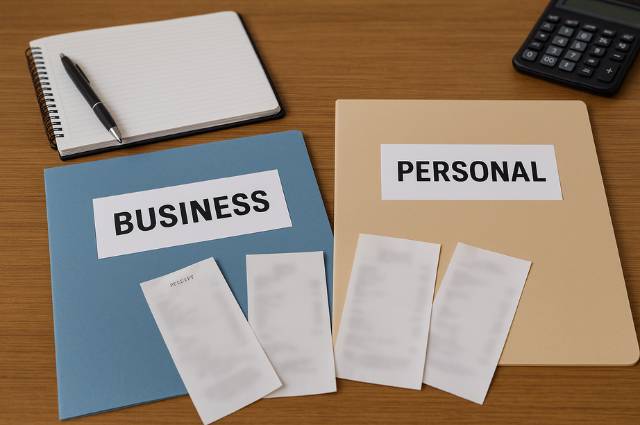Blending business and personal spending might feel convenient at the start, but it often creates confusion, missed deductions, and tax trouble down the road. For Canadian business owners and freelancers, keeping business and personal expenses separate is not just good practice—it is essential for accurate bookkeeping, proper tax filing, and CRA compliance.
When your financial records are clean and organized, you can easily see how your business is performing, avoid missed deductions, and protect yourself in case of an audit. Whether you run a growing company or work as a self-employed professional, the way you manage your expenses will directly impact your financial health.
If this feels overwhelming, our team can help — book a free consultation.
Why Keeping Business and Personal Expenses Separate Matters
- Accurate bookkeeping – No more confusion over which expenses belong where.
- Tax savings – Ensure you claim all eligible deductions without accidentally mixing in personal spending.
- Audit protection – If the CRA requests proof, having clean records strengthens your position.
- Clear financial insight – Know your real profit and cash flow at all times.
Without keeping business and personal expenses separate, you risk losing deductions, misreporting income, or facing penalties.
Open a Dedicated Business Bank Account
One of the easiest ways to separate your expenses is to open a bank account just for your business.
- Register it in your business name if applicable.
- Deposit all business income into this account.
- Pay for business expenses only from this account.
- Keep personal transactions strictly in your personal account.
This not only keeps records cleaner but also gives your business a more professional image when dealing with clients, suppliers, and lenders.
Use a Business Credit Card
Applying for a business credit card can make expense tracking much easier.
- Use it only for company purchases.
- The monthly statement acts like a built-in log of your purchases, making expense tracking much simpler.
- Avoid swiping it for personal needs, since one non-business purchase can blur the lines between your accounts.
- Many cards also provide rewards or cashback tailored to businesses.
Keeping all business charges on one card simplifies reconciliation at tax time.
Maintain Clear and Consistent Records
Strong bookkeeping depends on reliable records.
- Hold on to both electronic and paper copies of receipts.
- Log expenses promptly in your accounting system so details do not get lost.
- Stay current instead of letting transactions pile up.
- The Canada Revenue Agency requires that you keep supporting records for at least six years, so safe storage is a must.
Detailed records back up your claims and provide peace of mind if the CRA asks for proof of expenses.
Pay Yourself a Salary or Owner’s Draw
Rather than using business funds for personal purchases, transfer a set amount from your business account to your personal account as income.
- For corporations, this may be a salary or dividends.
- For sole proprietors, this is often an owner’s draw.
- Keep the transfer amount consistent when possible to help with budgeting.
This approach keeps your personal bills completely separate from business accounts, while still ensuring you get paid.
Work With a Professional Bookkeeper or Accountant
Even with the best intentions, it is easy for expenses to get mixed up. A professional can help you:
- Categorize expenses correctly.
- Identify and maximize eligible deductions.
- Avoid costly errors that could trigger CRA penalties.
- Provide financial insights that improve decision-making.
By outsourcing this task, you gain peace of mind knowing your finances are handled with care.
Keeping business and personal expenses separate is more than just tidy bookkeeping—it protects your company, maximizes deductions, and ensures compliance with Canadian tax rules. The small steps you take now will save stress, time, and money in the future.
Need guidance tailored to your situation? Schedule a free consultation with our team today, and we will help you set up a system that works.

